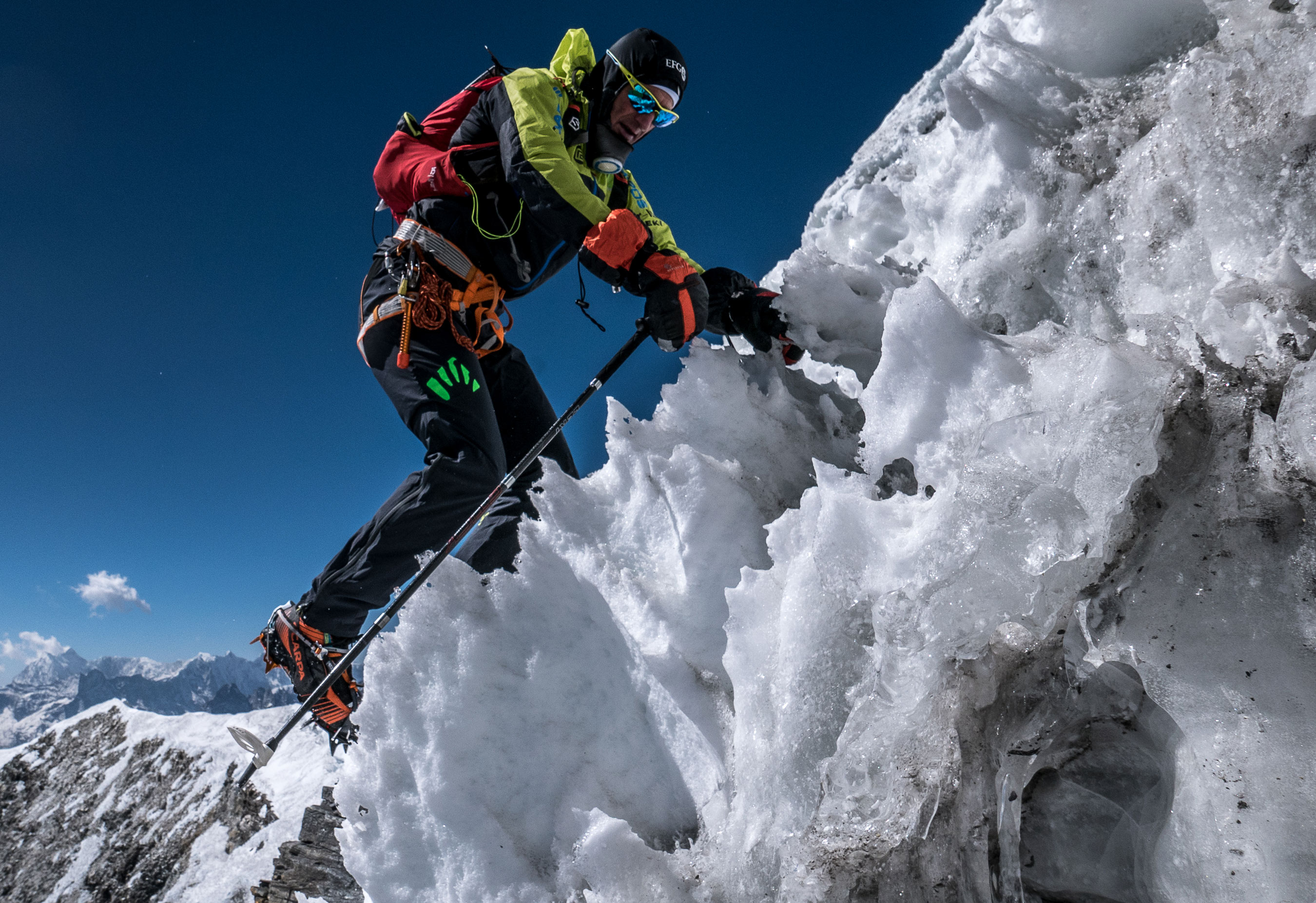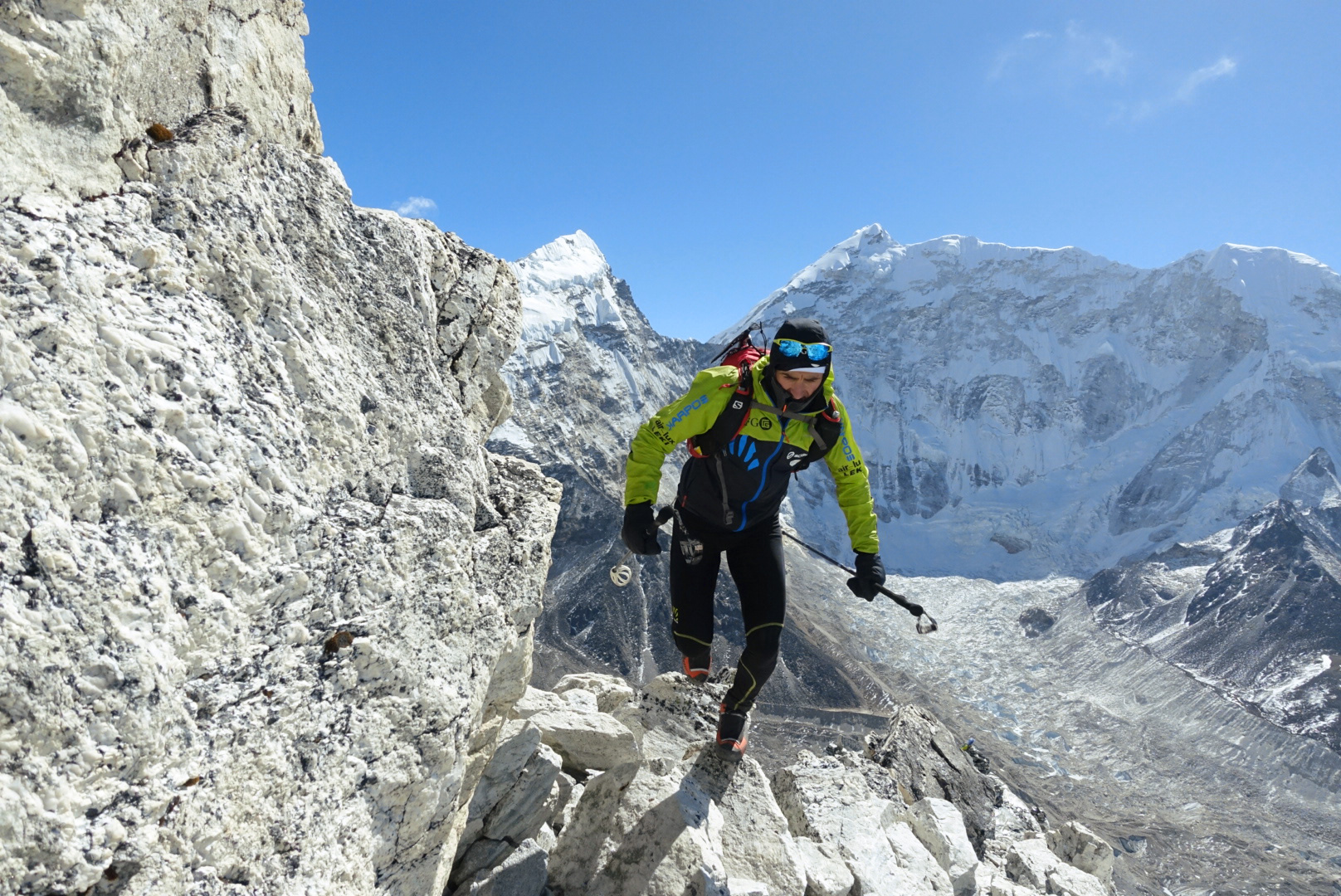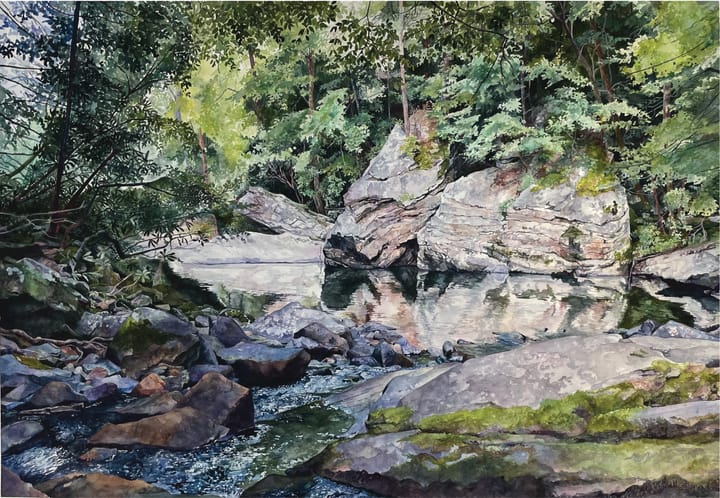Ueli Steck: The Carpenter Who Climbed Mountains

Ueli Steck, who died in Nepal on April 30, was probably this generation’s greatest alpinist. A goal like the Everest-Lhotse Traverse via the Hornbein Route, while a major coup if successful, was not objectively dangerous in the same way as his speed solos in the Alps. But in the end, climbing is serious business, and even the best are subject to the whims of chance in the high mountains.
UPDATE: Swiss alpinist Ueli Steck was cremated in Nepal on Thursday, May 4, according to a press release from his family. Steck’s wife Nicole and both of the couple’s parents attended a traditional Nepalese ceremony at Tengboche Monastery. The press release states, “The Family described the [ceremony] as solemn and impressive, sad and at the same time liberating.” The press release also offers further details of the circumstances surrounding Steck’s death. Though he initially intended to acclimatize on Everest on April 30, the night before “Ueli noted that the conditions [on] the Nuptse wall were ideal, which is why he decided in the evening to change his plan and to climb up to Nuptse the following day.” He began climbing on the 30th well before sunrise. “Ueli’s accident occurred [at] around 7600 meters at about 9.00 [a.m.] (local time),” the press release goes on. His body was retrieved by helicopter at an altitude of 6600 meters, meaning his fatal fall was approximately 1,000 meters in length. Despite this new information, exactly what happened up on Nuptse remains (and likely will continue to remain) unknown.A portion of Steck’s ashes will be scattered in his home country of Switzerland. For those wishing to offer condolences or share stories of the inspiration Ueli provided to them, please visit: http://www.uelisteck.ch/en/ripIn a video of Ueli Steck setting the speed record on the Eiger North Face in 2008, soaring aerial footage captures the Swiss alpinist daggering up the final, steep snow-slope to the summit ridge. The musician Radical Face’s anthemic song “Welcome Home” combines with the jagged peaks to create a timeless, limitless moment. In those frames, Ueli is invincible.
It came as a shock to the entire climbing community when, on April 30, news spread that Ueli Steck had died in Nepal. He was in the Khumbu to attempt a bold new enchainment that would have linked Everest and Lhotse, via the unrepeated 1963 Hornbein Route on the former. Steck arrived in the region in early April to train and acclimatize with partner Tenji Sherpa.
On April 30, Steck was climbing alone on Nuptse (the third peak in the horseshoe after Everest and Lhotse) as part of his acclimatization regimen. Details are still fuzzy as to what precisely took place. On his blog, veteran Everest chronicler and climber Alan Arnette shared a report from Larry Daugherty, a member of Adventure Ascents’ 2017 Everest expedition: “Body found at the base of West Nuptse, climber apparently fell alone and unprotected. Initially, it was suspected to be Ueli based on clothing and apparently his acclimatization plan...then they confirmed with my team 10 minutes later it was in fact him.”

Steck’s body was recovered swiftly and airlifted to Lukla, the only airstrip in the Everest region, where it was flown to Kathmandu.
A representative for Steck told The Outdoor Journal that his family members were en route to Nepal and that it is their wish to have Ueli’s funeral there. Steck is survived by his wife Nicole. He was 40 years old.
The Outdoor Journal interviewed Steck about his Everest-Lhotse plans on April 4, just before he flew to Nepal. When asked about the serious nature of such a climb, he acknowledged that anything in the Himalayas carries with it different kind of seriousness: “Yea, I mean, you’re exposed... it’s 8,000 meters.”
But part of the shock felt by climbers around the world at Ueli’s death stems from his complete mastery on the type of terrain he was dealing with on Everest, Lhotse and Nuptse. “For me, for example, I can move really comfortably in this kind of terrain. Coming down from 8,000 meters—let’s take the South Col—I know I can be in Camp 2 in one-and-a-half hours,” Steck said. “And on this terrain, like the Hornbein, I can move up and down however I want without needing any technical equipment. It’s a skill I’ve worked on over 20 years. This terrain, which is serious climbing for other people, is basically like walking for me.”
Before leaving for Kathmandu, he told The Outdoor Journal, “I only do stuff I feel comfortable with, except a few climbs I’m not proud of. I know what it means to be up on Everest. I have a lot of respect for the mountain. But I’m not scared.”
Ueli Steck was born in Lagnau im Emmental, Switzerland in 1976. He began climbing at the age of 12, and first climbed the Eiger—the mountain with which he will forever be linked—at 18. He trained as a carpenter and began working in his home country, all the while pushing the level of his climbing. In an email to The Outdoor Journal from Tajikistan, Billi Bierling, mountaineering journalist and assistant to Himalayan archivist Miss Elizabeth Hawley, notes, “When you look at [Ueli’s] CV on his website, it says: ‘Profession: Trained Carpenter’ even before he lists all his incredible mountaineering achievements.” It was this down-to-earth “modesty” that Bierling admired in him.
Steck first gained acclaim for his solo ascents on the Eiger North Face. In 2007, he took the speed record under four hours for the first time in history.
2008 was a career-defining year for Steck. On February 13 of that year, he set a new, blisteringly fast speed record on the Eiger North Face, at 2 hours 47 minutes and 33 seconds. Then on April 24, Steck and climbing partner Simon Anthamatten, capped a three-day first ascent of the northwest face of Nepal’s Teng Kang Poche (6,487 m), a climb for which they were awarded the Piolet D’Or in 2009. Finally, as icing on the cake, from August 29 to 30, he left his mark in the Eiger’s history of hard, pure rock routes. Along with Stephan Siegrist, Steck made the first free ascent of Paciencia, a route that the two had cleaned and bolted in 2003. The climb became the hardest rock climb on the Eiger, ascending 23 pitches to the top of the wall, the hardest clocking in at 8a (5.13b).
Steck acquired the nickname of “the Swiss Machine,” due to his extreme speed, diligent training and seeming perfection in the alpine. But according to Billi Bierling, also a friend of Steck’s, “Ueli NEVER liked the term ‘Swiss Machine.’ He was branded with it but never liked it.”

His achievements in the 2010s were just as noteworthy as he turned his attention more and more to the Himalayas. In 2011, he soloed Shishapangma (8,027 m) in just ten-and-a-half hours, and in 2012 he summited Everest for the first time (both without supplemental oxygen).
Then in 2013, he completed a climb for which he won his second Piolet D’Or: a solo, 28-hour round-trip first ascent of Annapurna’s South Face via the previously unfinished Lafaille Route.
His 2013 solo of Annapurna followed hot on the heels of a now infamous controversy on Everest between Steck, Simone Moro, and Jonathan Griffith on one side, and Sherpa ice doctors fixing ropes on the other. Steck, Moro and Griffith had come to Everest with the goal of attempting the same Everest-Lhotse Traverse which Steck intended to attempt with Tenji Sherpa this season before his death. The exact circumstances of the debacle remain convoluted to this day, but the events revolved around the Western climbers moving above the Sherpa as they fixed ropes, and accidentally raining down ice on them; an exchange of words, including Nepalese slurs directed at the Sherpa; and a subsequent altercation at the climbers’ camp in which the Sherpa physically attacked them.
Following 2013’s extreme highs and lows represented by his Annapurna solo and the Everest altercation, Steck shifted focus back to his stomping grounds in the Alps for the next couple of years. In 2015, over the course of 62 days, Steck climbed every peak in the Alps over 4,000 meters high as part of his 82 Summits project.
But the Hornbein Route and the Everest-Lhotse Traverse remained firmly imprinted in Ueli’s mind. It took him two failed trips before he finally succeeded in climbing Annapurna’s South Face. Before he departed for his third, successful attempt on the face back in 2013, he was quoted in an article at swissinfo.ch as saying, "The South Face of Annapurna I is an old project. I have attempted it twice already and I guess you need patience if you want to climb hard routes on an 8000m-peak. Sometimes you have a lucky punch, but often you have to go back, and everything has to be right." Having proven this idea to himself on Annapurna, and with the aesthetic, historic appeal of the Everest-Lhotse Traverse, it was only a matter of time before he decided to head back to the Khumbu for unfinished business.
But it was not meant to be this time around. Ueli’s aura of invincibility from the 2008 Eiger video was just that—an aura. Even the best are subject to the whims of chance in the high mountains. Ueli Steck’s passing has left an unfillable void in the greater ranges of the world. The mountains have never seen a climber quite like him, and they may not again for a long time to come.

Below are additional thoughts from Billi Bierling, shared exclusively with The Outdoor Journal:
“When I heard about this tragic accident on Sunday morning, I was in the midst of translating his latest book, which I have been working on for the past two months. Ueli and I were very excited when one of his books was finally going to be published in the English-speaking world as he always wanted to have an English version of one of his works. So I have lived and breathed Ueli for the past two months. I would like to share an excerpt from the Annapurna South Face chapter, which I re-read several times after I had heard about his accident. Maybe this section can help us understand where Ueli was coming from:
I was completely detached from the other world. There was nothing else but climbing. No goal, no future, no past. I was climbing in the here and now. One swing of the ice axe after the other; one step after the other. I only saw my ice axes and how they penetrated the snow and ice. My view narrowed and I had adopted some sort of tunnel vision. And here I was; in the middle of this gigantic face with very limited equipment. I felt light, but also extremely exposed. I knew that the tiniest mistake would mean certain death. However, I was not scared of making a mistake. I was still giving orders and controlling the person climbing the south face of Annapurna. It did not feel like me. If this person fell, it would not really concern me.
I remember when I once asked him how he could possibly NOT be scared when scaling such huge steep faces unroped, he responded: ‘Climbing is like walking the stairs. I never expect to slip and fall. Do you?’ And this is exactly how he viewed climbing - like walking the stairs. But unfortunately, on Sunday he slipped and fell, and it is a great loss for the climbing community, a great loss for his friends and family and of course a huge loss for his wife Nicole. My thoughts are with all of them and I will certainly remember Ueli as an amazing climber, a good friend and an inspiration for a lot of people. Despite his speed ascents he never lost his love and passion for the mountains.”





Comments ()